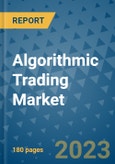Growing Adoption by Hedge Funds and Institutional Investors
In the past two years, there has been a significant trend towards widespread deployment of algorithms across asset classes, especially cross-asset automation. Hedge funds are rapidly utilizing algorithms to trade the majority of their portfolios and often rely on multiple providers for a multi-asset portfolio. Improved trader productivity, reduced market impact, consistent execution performance, ease of use, and cost-effective commission rates are some of the main factors driving the adoption of algos by hedge funds and institutional investors. The general level of automation and electronification has also witnessed a discernible increase, leading to higher demand for algorithmic trading services and products.COVID-19 Impact on Algorithmic Trading Market
The COVID-19 pandemic has accelerated the growth of the algorithmic trading market, as it facilitates quick decision-making and minimizes human errors during times of market volatility. Market participants introduced cutting-edge algorithmic trading solutions to cater to the increasing trading volumes witnessed during the pandemic. Notably, institutions like Cowen Inc. released algorithmic trading solutions to help institutional clients navigate the market dynamics influenced by a surge in retail trading volume.Institutional Investors Drive Market Expansion
Institutional investors, such as insurance firms, exchange-traded funds, pension funds, and mutual fund families, have embraced algorithmic trading to reduce trading expenses. Algorithmic trading is particularly advantageous for executing large orders, allowing investors to minimize trading costs and enhance profitability. Institutions utilize computer-driven algorithmic strategies across various asset classes, including the stock market, to achieve these objectives. The ability to automate trading processes, react to market conditions instantly, and reduce human error makes algorithmic trading a sought-after investment choice.Government Regulations Boost Market Growth
Government regulatory bodies worldwide are actively exploring ways to manage algorithms and implementing rules to safeguard algorithmic trading. Regulations aim to prevent market manipulation and ensure market safety for customers. For instance, the Financial Industry Regulatory Authority (FINRA) proposed a rule requiring algorithmic trading developers to register as securities traders, which has been accepted by the U.S. Securities and Exchange Commission (SEC). Similarly, the Securities and Exchange Board of India (SEBI) unveiled a new order-to-trade ratio (OTR) framework in June 2020, further supporting the algorithmic trading sector.Challenges in Algorithmic Trading Market
While algorithmic trading is gaining traction, stringent regulations and limited acceptance in some regions present challenges to market growth. Regulatory bodies are strengthening control over algorithmic trading to identify potential systemic flaws as automated trading systems become more prevalent. Addressing these challenges will require sophisticated risk management solutions and advancements in the algorithmic trading market.Stock Market Category Dominates Market Share
The stock market category holds the largest market share in algorithmic trading, offering a safe and controlled environment for trading a wide range of assets. Financial and brokerage organizations benefit from the advantages of stock markets, such as risk management and increased profitability, encouraging the use of algorithmic trading solutions. The cryptocurrency segment is also expected to witness significant growth, driven by growing interest in bitcoin trading and the availability of real-time market data from supported cryptocurrency exchanges.Cloud Solutions Lead Algorithmic Trading Market
Cloud-based solutions dominated the algorithmic trading market in 2021, with vendors focusing on providing cost-effective, scalable, and efficient trading solutions. Cloud-based solutions offer advantages such as easy data upkeep, efficient management, and faster processing compared to on-premise solutions. The increasing use of cloud-based solutions by financial institutions to enhance productivity and efficiency further drives market growth.North America Spearheads Algorithmic Trading Market
North America holds the largest revenue share in the algorithmic trading market, driven by investments in trading technologies and algorithmic trading suppliers. The region's expanding government support for international trade and the widespread adoption of algorithmic trading on Wall Street contribute to its leadership position. The Asia Pacific region is also expected to witness stable revenue growth, fueled by significant investments in trading technologies and a rise in demand for algorithmic trading platforms.Global Algorithmic Trading Market: Competitive Landscape
In October 2022, the Multi Commodity Exchange of India Limited (MCX) entered into a strategic partnership with 63 Moons Technologies for software technology services, aimed at maintaining a seamless trading experience for three months. This collaboration is set to enhance the technological capabilities of MCX and further strengthen its position in the algorithmic trading market.Similarly, in June 2022, Fernhill Corp. made a significant announcement regarding MainBloq, a state-of-the-art digital asset trading platform widely used by banks and hedge funds. The two entities signed a multi-year contract, focusing on providing smart order routing, automated algorithmic trading, and customized trading solutions to optimize the overall trading performance of India-based CryptoWire. This partnership is expected to revolutionize the trading landscape in the cryptocurrency domain.
Among the key players in the algorithmic trading market are 63 moons, Virtu Financial, Software AG, Refinitiv Ltd., Metaquotes Software Corp., Symphony Fintech Solutions Pvt Ltd, Argo SE, Tata Consultancy Services, Algo Trader AG, and Tethys. These companies are at the forefront of driving innovation and technological advancements in the algorithmic trading space.
Table of Contents
Companies Mentioned
- Tradetron
- TradeStation
- 63 Moons Technologies
- Tickblaze LLC
- Argo Software Engineering
- Wyden
- Symphony
- Algotraders
- Inforeach Inc.
- Refinitiv Ltd.
- FXCM Group
- TCS
- Tethys








